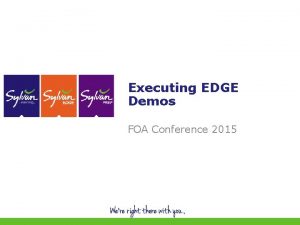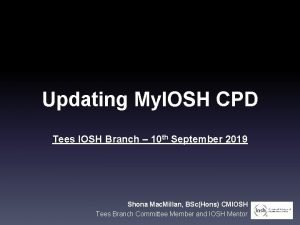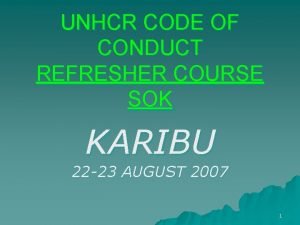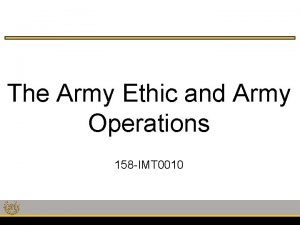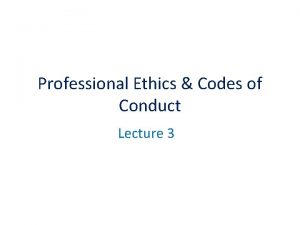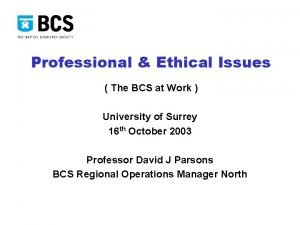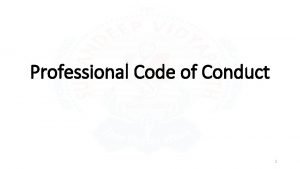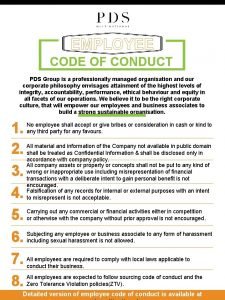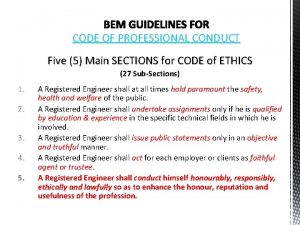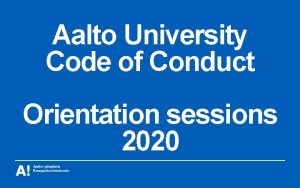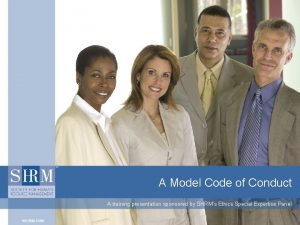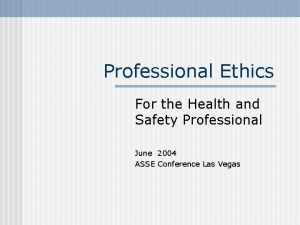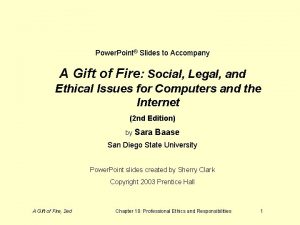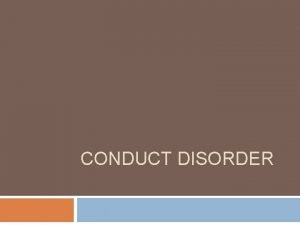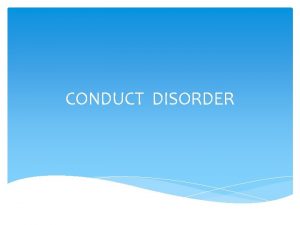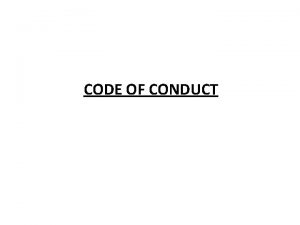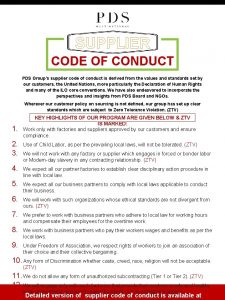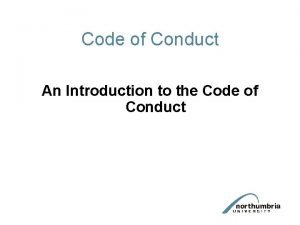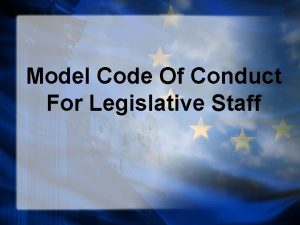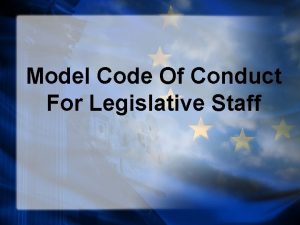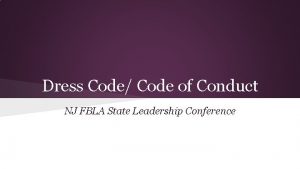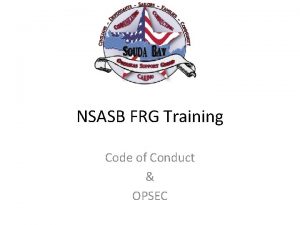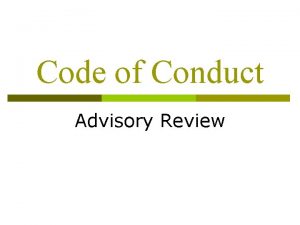Developing a Code of Conduct 2015 NMSU Conference


















- Slides: 18

Developing a Code of Conduct 2015 NMSU Conference (for Promoting Ethical Business Practices in the Non-For-Profit, Health Care, and Social Service Sectors) Winnie Lee Associate Professor of Economics; Assistant Director of the Daniels Fund Ethics Initiative (DFEI) NMSU Department of Economics, Applied Statistics, and International Business -------------------------Terms of Use: The author created this material for classroom use in conjunction with NMSU’s Daniels Fund Ethics Initiative. No permission or compensation is needed for classroom use as long as it is acknowledged to be the creative work of the author and NMSU’s Daniels Fund Ethics Initiative. For publication or electronic posting, please contact NMSU’s Daniels Fund Ethics Initiative 1 -575 -646 -4083. Copyright 2014 - NMSU College of Business. -------------------

Ethics • What Is Ethics? • Why Is Ethics Important? • How to Develop Ethical Culture and the Code of Conduct in an Organization?

What Is Ethics? • Ethics – “Shared expectations for behavior in particular circumstances” (Baird, 2010) • “Morality… is our individual moral compass that lets us know what behavior we expect of our selves and others in particular situation. ” (Baird, 2010)

What Is Ethics? (Values versus Principles) Values-Based Ethics Principle-Based Ethics Values are formed relative to the individual and given situation. Principles provide a ‘right-vs. -wrong’ standard for an individual’s behavior. Values are broadly-defined and can be subjective and varying across cultures. Principles teach an individual to ‘do what is right, NOT what is best. ’ Values lead to choice and are used to Principles are universal, used to develop socially enforceable norms (i. e. develop rules (i. e. written guidelines; unwritten laws; e. g. washing hands e. g. traffic rules) across cultures. before eating). Rawlsian Ethics (Rawls, 1971): Principles Values Norms Behavior

What is Ethics? Have You Ever Encountered an Ethical Dilemma?

Why Is Ethics Important? • Ethics is important, because: – It helps building trusts! • Increase in commitment and cooperation • Decrease in uncertainty and possible conflicts – In an organization, it helps enhancing organizational reputation and productivity!

How to Develop Ethical Culture and a Code of Conduct in an Organization? • Ethical Organizational Culture means both leaders and subordinates in an organization are: – Collaboratively creating a code of ethics with proper reinforcement and consequences – Cohesively following ethical codes and practices in their jobs and business

How to Develop Ethical Culture and a Code of Conduct in an Organization? • Common examples of ethical codes: Common Examples of Ethical Codes Respect Integrity Transparency Fairness Honesty Accountability Avoidance of Co. I Confidentiality Inter-partner Relationship Trust & Credibility Legal & Compliance Loyalty Teamwork & Sportsmanship Environmental Safety Professionalism Leadership Avoidance of Malpractice Standard & Practicability Commitment for Proactivity Improvement

Example of DFEI Principles: Integrity, Trust, Accountability, Transparency, Fairness, Respect, Rule of Law, and Viability

Example of DFEI Principles: Integrity, Trust, Accountability, Transparency, Fairness, Respect, Rule of Law, and Viability • http: //www. danielsfund. org/Grants/Ethics. Initiative. asp • http: //business. nmsu. edu/research/programs/d aniels-ethics/

How to Develop Ethical Culture and a Code of Conduct in an Organization? • Main Components Built to Code of Ethics/Conduct: (http: //www. shrm. org/templatestools/samples/policies/pages/cms_014093. aspx) – Organizational Core Values and Vision • Core value and vision statement – Organizational Mission • Mission statement – Ethical Culture and Practice • Main ethical codes and compliance – General and field practices; reinforcement; consequence – Avoidance of Injustice – Information and Resources • Reporting structure

How to Develop Ethical Culture and a Code of Conduct in an Organization? • Example #1: Code of Conduct, Hospital Corporation of America (HCA) – http: //hcaethics. com/ethics/code/Code. Of. Conduct. pdf • Example #2: Code of Ethics and Standards of Practice, National Association for Healthcare Quality (NAHO) – http: //www. nahq. org/uploads/files/about/codestandards. pdf

You! Leaders!!

Leaders’ Ethical Responsibility • “The distinguishing mark of leadership and executive responsibility is influencing the moral behavior of others. ” – Chester Barnard, The Functions of the Executive (1938) • “Management is doing things right; leadership is doing the right things. ” – Peter Drucker, The Essential Drucker (2008)

Leaders’ Ethical Responsibility • Chinese proverb: “上樑不正下樑歪!” (shàngliáng-bú-zhèng-xià-liáng-wāi) – “If the upper beam is not straight, the lower ones will go aslant. ” • “Fish begins to stink at the head!” • When a leader fails to set a good example, his followers will follow suit. • Leaders! Being ethical & set good models!

Reference • 1. Reference of Conference Presentation Materials – Von. Osten, J. , and Lightsey, A. (2013), “Dona Ana Country: A Study of Local Government Ethics”, annual report, available at http: //business. nmsu. edu/research/programs/daniels-ethics/teaching/ethical-codes/ – Huhmann, B. (2013), “Creating an Ethical Culture” (for NMSU Course CPM 139), presentation materials. – Huhmann, B. (2012 a), “Module: Principle-Based Ethics”, presentation materials. – Huhmann, B. (2012 b), “Module: Principle-Based Ethics”, presentation materials. – Huhmann, B. (2012 c), “Module: Why Ethics Matter in Business”, presentation materials. – Small Business Chron, available at http: //smallbusiness. chron. com/importance-ethicsorganizations-20925. html

Reference • 2. Reference of Field Study – Ethics Case Studies, by American College of Physicians (ACP), available at https: //www. acponline. org/running_practice/ethics/case_studies/ – AMA Journal of Ethics, by American Medical Association (AMA), available at http: //journalofethics. ama-assn. org/site/cases. html – Ethics Case Studies, by The Center for Bioethics & Human Dignity (Trinity International University), available at https: //cbhd. org/resources/case-studies – Code of Ethics for Health Care Compliance Professionals, by Health Care Compliance Association (HCCA), available at http: //www. hccainfo. org/Portals/0/PDFs/Resources/HCCACode. Of. Ethics. pdf – Code of Ethics, by Association for Healthcare Documentation Integrity (AHDI), available at http: //www. ahdionline. org/Member. Center/Codeof. Ethics/tabid/279/Default. asp

Q & A • Q & A • Thank You!
 Led conference 2015
Led conference 2015 Ulvan
Ulvan Insight 2015 conference
Insight 2015 conference Iosh code of conduct
Iosh code of conduct Unhcr code of conduct
Unhcr code of conduct Pow code of conduct
Pow code of conduct Consolidation of gains
Consolidation of gains General moral imperatives
General moral imperatives Bcs code of conduct
Bcs code of conduct Code of conduct professional ethics
Code of conduct professional ethics Navy values and standards
Navy values and standards Employee code of conduct
Employee code of conduct Project management code of conduct
Project management code of conduct Code of conduct articles
Code of conduct articles Bem code of conduct
Bem code of conduct Aalto code of conduct
Aalto code of conduct Code of conduct training ppt
Code of conduct training ppt Bcsp code of ethics
Bcsp code of ethics Cips code of ethics and professional conduct
Cips code of ethics and professional conduct

